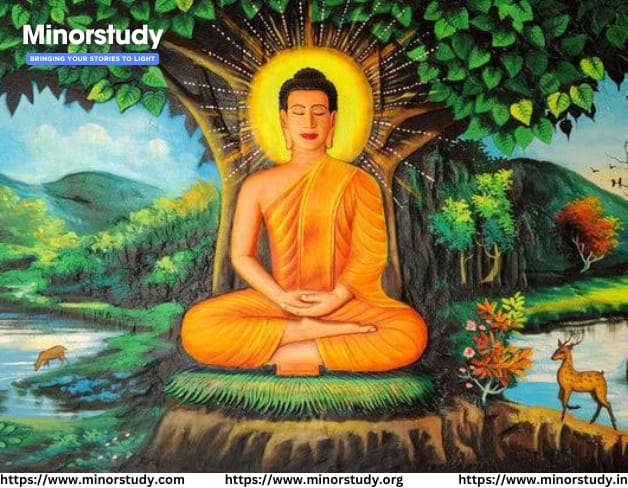🌱 Introduction: Siddhartha Gautama A Human Journey to Awakening
Siddhartha Gautama—known in history and hearts as the Buddha—was born a prince, raised in privilege, yet chose renunciation and wisdom over wealth and power. His journey from sheltered royalty to enlightened teacher brought to the world the timeless truths of awakening, compassion, and inner freedom.
- 🕊️ History of Siddhartha Gautama: From Prince to Buddha
- 1. Birth and Royal Beginnings (c. 563 BCE)
- 2. The Four Sights (c. 534 BCE)
- 3. Renunciation and Search (c. 534–528 BCE)
- 4. Enlightenment under the Bodhi Tree (c. 528 BCE)
- 5. Teaching Years (c. 528–483 BCE)
- 6. Parinirvana (c. 483 BCE)
- 🧠 7 Fascinating Facts About the Siddhartha Gautama
- 🗓️ Timeline of Key Events in the Buddha’s Life
- 💡 Significance: Why the Buddha Matters to Us
- 🧘 Path to Inner Freedom
- 🌍 Universal Compassion
- 🧭 A Model of Balanced Life
- 🗣️ Teachers Over Theologians
- 🕊️ Seed of Nonviolence
- 📌 Siddhartha Gautama Daily Life Impacts & Observance Today
- 💬 Heartfelt Wishing Message
- ❓ Siddhartha Gautama FAQs About Siddhartha Gautama
- 👣 Who was the Buddha?
- 🧑🎓 What are the Four Noble Truths?
- 🛤️ What is the Eightfold Path?
- 🙏 Is Buddha a god?
- 🕰️ When did he live?
- 🌐 What is his impact on the world?
- 📌 Siddhartha Gautama Important Points to Remember
- 🔚 Conclusion: The Continuing Light of Siddhartha Gautama
But who was this man? What did he do that continues to touch millions? And how can his story inspire your daily life today? Let’s explore, human to human.
🕊️ History of Siddhartha Gautama: From Prince to Buddha
1. Birth and Royal Beginnings (c. 563 BCE)
Siddhartha was born in Lumbini (modern-day Nepal) to King Suddhodana and Queen Maya. His father, fearing a prophecy of either great spiritual or royal destiny, shielded him from suffering and kept him within the palace’s luxurious walls.
2. The Four Sights (c. 534 BCE)
On rare excursions beyond the palace, Siddhartha witnessed four life-altering sights: an old man, a sick person, a corpse, and a renunciant monk. These “Four Sights” shattered his sheltered worldview and ignited a deep spiritual quest.
3. Renunciation and Search (c. 534–528 BCE)
At age 29, Siddhartha left his wife and newborn son and began life as an ascetic. He studied under various teachers, practiced severe austerities, but still found no lasting liberation.
4. Enlightenment under the Bodhi Tree (c. 528 BCE)
Realizing extremities didn’t lead to freedom, he adopted the Middle Path, disciplined his mind through meditation, and achieved enlightenment at Bodh Gaya at age 35, becoming the Awakened One—the Buddha.
5. Teaching Years (c. 528–483 BCE)
For about 45 years, Buddha traveled across northern India—teaching the Dhamma (truth), establishing the Sangha (monastic community), and guiding thousands from suffering to wisdom.
6. Parinirvana (c. 483 BCE)
At age 80, at Kushinagar, Buddha entered final passing (Parinirvana). His physical form ceased, but his teachings lived on eternally in the hearts of millions.
🧠 7 Fascinating Facts About the Siddhartha Gautama
⚖️ Noble Name Meaning: “Siddhartha” means “he who achieves his aim,” and “Gautama” is his family name.
🐎 His Chariot Horse’s Name: Kanthaka, who returned to the palace mournfully after his departure.
🍂 The First Sermon: Delivered at Sarnath, introducing the Four Noble Truths and the Eightfold Path.
🧸 A Humble Teacher: rejected worship—encouraged students to test his words through experience.
🌎 World Traveler: Taught kings, commoners, brahmins, and outcasts alike.
🕯️ No Divine Claim: Buddha presented himself as a guide, not a deity.
📜 Oral Legacy: His teachings were preserved orally by disciples long before being written down centuries later.
🗓️ Timeline of Key Events in the Buddha’s Life
| Year (approx.) | Event |
|---|---|
| 563 BCE | Birth in Lumbini |
| 534 BCE | Witnessed the Four Sights |
| 534 BCE | Left the palace to seek liberation |
| 528 BCE | Enlightenment under Bodhi Tree in Bodh Gaya |
| 528 BCE | First sermon at Sarnath |
| 528–483 BCE | Teaching across northeast India; founding the Sangha |
| 483 BCE | Parinirvana (passing away) in Kushinagar |
💡 Significance: Why the Buddha Matters to Us
🧘 Path to Inner Freedom
His teachings reveal how to find an end to suffering—through inner awareness, ethical living, and mental balance.
🌍 Universal Compassion
Buddha upheld metta (loving-kindness), teaching that every living being deserves empathy. Today, this inspires global movements in mindfulness and humanistic psychology.
🧭 A Model of Balanced Life
The Middle Path steers us between extremes—whether in work, pleasure, discipline, or indulgence. It encourages mindful balance.
🗣️ Teachers Over Theologians
Buddha urged us to see for ourselves, fostering an empirical, experiential path to truth rather than blind faith.
🕊️ Seed of Nonviolence
His teaching against killing and unnecessary harm led to powerful nonviolent currents and ethical philosophy globally.
📌 Siddhartha Gautama Daily Life Impacts & Observance Today
Though Siddhartha lived 2,500 years ago, his ways are alive in everyday life:
Mindfulness Practices: Pause, observe breath and mind—reduce stress, increase focus.
Meditation: Cultivates clarity, calm, and emotional resilience.
Ethical Living: Practicing compassion, honesty, and respect builds trust and social harmony.
Letting Go: Buddha’s wisdom of impermanence helps reduce attachment and mental suffering.
Community Gatherings: Buddhist temples, meditation groups, and Dharma circles connect modern seekers worldwide.
💬 Heartfelt Wishing Message
“May the wisdom of Siddhartha’s journey inspire your moments—may your mind find clarity, your heart overflow with compassion, and your life walk the Middle Path of balance, peace, and freedom.”
❓ Siddhartha Gautama FAQs About Siddhartha Gautama
👣 Who was the Buddha?
He was a historical figure—born a prince—who renounced privilege to discover liberation from suffering, and who shared his insights as the Awakened One.
🧑🎓 What are the Four Noble Truths?
Life involves suffering (dukkha).
Suffering has a cause: craving and ignorance.
Suffering can end—through liberation (Nirvana).
The path to the end of suffering is the Eightfold Path.
🛤️ What is the Eightfold Path?
A guide to ethical, mindful living:
Right Understanding, Thought, Speech, Action, Livelihood, Effort, Mindfulness, Concentration.
🙏 Is Buddha a god?
No—Buddha considered himself a teacher and guide, not a divine being. His teachings encourage self-empowerment and insight.
🕰️ When did he live?
Circa 563–483 BCE, though scholars vary—these are traditional dates accepted across much of Asia.
🌐 What is his impact on the world?
His teachings sparked Buddhism—which over centuries shaped art, philosophy, ethics, and mental well-being practices across Asia and the modern West.
📌 Siddhartha Gautama Important Points to Remember
Not a Myth—He was a real person with a direct journey from privilege to awakening.
Timeless Teachings—Centered on universal human experience—suffering, joy, change.
Nonsectarian Approach—Offered a universal path, not bound by culture, theology, or status.
Balanced Wisdom—He ignored extremes—favoring clarity, kindness, and self-knowledge.
Living Legacy—More than religion—his path informs modern psychology, ethics, social reform, and mindfulness.
🔚 Conclusion: The Continuing Light of Siddhartha Gautama
Siddhartha Gautama’s life illustrates one fundamental truth: awakening is available to all—no exception. His path offers a way to move from suffering to peace, from ignorance to insight, and from separation to compassion.
In modern times—rushed, anxious, digitally saturated—his timeless guidelines serve as a human roadmap for mindful living, intentional kindness, and balanced growth.
Let his life story be a quiet invitation: take time… observe your breath… extend kindness… live wisely.








